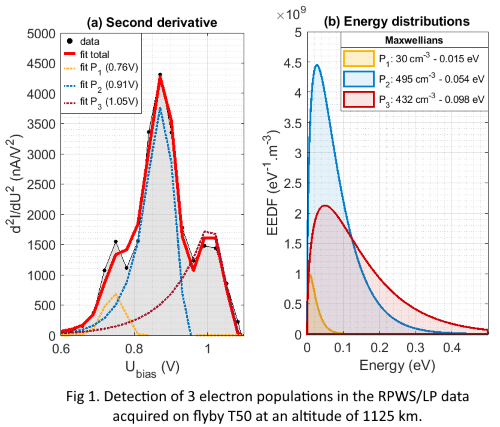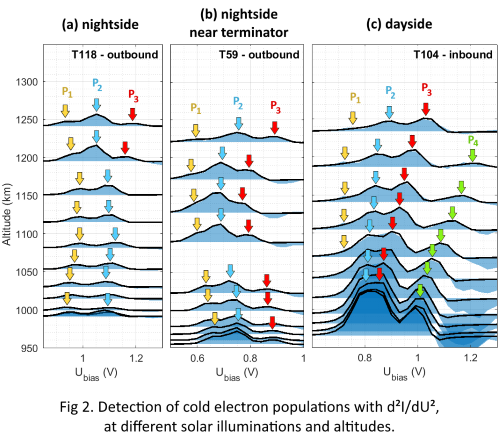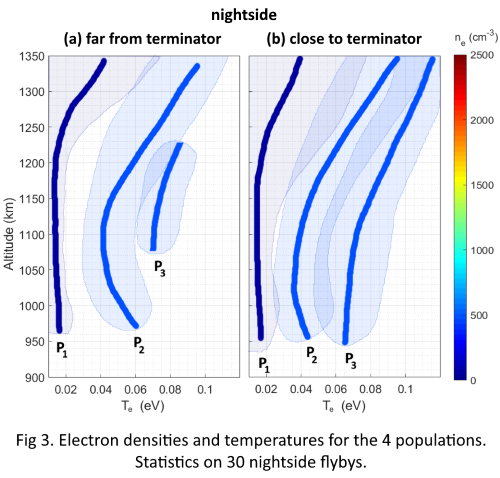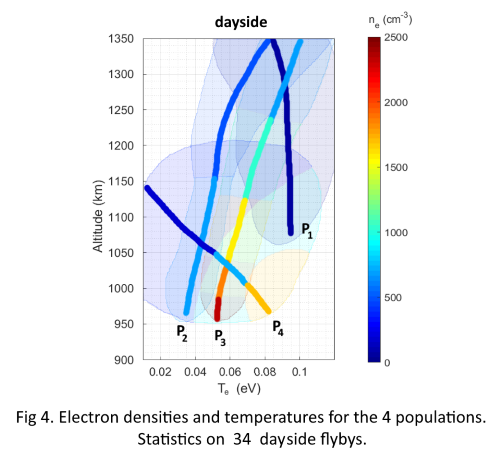Re-analysis of the Cassini RPWS/LP data in Titan ionosphere: electron density and temperature of four cold electron populations
- 1Université Paris-Saclay, UVSQ, CNRS, LATMOS, Guyancourt, France (audrey.chatain@latmos.ipsl.fr)
- 2LPP, Ecole polytechnique, Sorbonne Université, université Paris-sud, CNRS, Palaiseau, France
- 3Swedish Institute of Space Physics, Uppsala, Sweden
- 4Imperial College London, UK
The Cassini Langmuir Probe (LP) data acquired in the ionosphere of Titan are re-analysed to finely study the electron behaviour in the birthplace of Titan’s aerosols (900-1200 km). The detailed analysis of the complete Cassini LP dataset below 1200 km (57 flybys) shows the systematic detection of 2 to 4 electron populations, with reproducible characteristics depending on altitude and solar illumination. Their densities and temperatures are deduced from the Orbital Motion Limited theory. Statistical correlations with other quantities measured by Cassini are investigated. We finally discuss the origins of the detected populations, one being possibly emitted by aerosols.
1- Introduction
The Cassini mission discovered that Titan’s ionosphere is the birthplace of the solid orange aerosols surrounding Titan [1]. It is an ionized environment (plasma) hosting a complex ion chemistry [2]. The aerosols are formed and certainly eroded [3] in this environment. They are likely to interact strongly with the plasma species (i.e. electrons, ions, radicals and excited species): the ionosphere of Titan is a ‘dusty plasma’ below ~1100 km [4], [5]. Besides, models of the ionosphere do not match well measurements below 1100 km [6]. Recent works [7]–[9] showed the necessity to take negative ions and aerosols into account in the models.
The present work aims to finely analyse the behaviour of electrons in the aerosols-containing region of the ionosphere (~900-1200 km) sounded at 57 occasions by the Cassini Langmuir Probe (LP), part of the Radio and Plasma Wave Science (RPWS) package.
2- Re-analysis using 2 to 4 electron contributions
The current collected by the Langmuir probe in the conditions of the ionosphere of Titan can be modelled according to three hypotheses: (1) the electron velocity distributions are considered Maxwellians; (2) in the case where the probe repels electrons, the current collected can be given by the Orbital Motion Limited (OML) theory [10], [11]; (3) in the case where the probe attracts electrons, the current is fitted using the Sheath Limited theory [12].
To obtain a satisfactory fitting, we show the necessity of using 2 to 4 electron populations (named P1, P2, P3 and P4) at different potentials [13]. We observe (see Figure 1) that the second derivative of the current is useful to deduce the number of electron populations detected on a measurement and gives an idea of their relative proportions. Indeed, d²I/dU² is physically related to the electron energy distribution functions (EEDF) through the Druyvesteyn method [14].

3- Populations: strong dependence with SZA and altitude
The visualisation of electron populations with d²I/dU² is used in Figure 2 to show the variations of the populations with altitude and solar illumination. Populations P1 and P2 are always present, contrarily to P3 and P4. Due to their low density and low potential, P1 electrons are suspected to be photo-electrons [10] or secondary electrons emitted on the probe stick. P3 electrons are only absent on the far nightside, while P4 electrons are detected only on dayside, and below the altitude of 1200 km. For this reason, they are suspected to be related to aerosols or heavy negative ions that appear below 1200 km.

4- Densities and temperatures for all the electron populations
Figures 3 and 4 give statistics on electron densities and temperatures measured for all the populations for the 57 Cassini flybys reaching at least 1200 km. They show that electron temperatures do not vary much with altitude between 1200 and 950 km, except for P4. P3 and P4 have increasing densities with pressure on dayside.


5- Statistics
The large dataset enables to do statistics and search for correlations. In particular, we observe that P3 and P4 densities are correlated with the extreme UV flux. This enforces the idea that these populations are formed by processes involving solar photons (certainly UV).
We also observe a strong correlation between the density and the temperature of the P4 population, as illustrated in Figure 5.

6- Conclusion: origins of the detected electron populations
From the above results we suggest possible origins for the three populations P2, P3 and P4, coming from the plasma surrounding the probe:
-P2 is detected in all cases, at rather low density (~500 cm-3) and temperature (~0.04 eV). These are supposed to be background thermalized electrons, possibly formed through collisions of gas species with magnetospheric suprathermal electrons.
-P3 electrons are denser with stronger solar illumination and higher pressure (up to 3000 cm-3). They are hotter than P2 electrons (~0.06-0.07 eV). Therefore, they could be formed by the photo-chemistry occurring in Titan’s ionosphere.
-P4 electrons are only observed on dayside and below 1200 km, in the place where heavy negative ions and aerosols are present. We suggest two possible formation processes: (1) the photo-emission of electrons from grains could be triggered by photons of a few eV due to the negative charge born by the aerosols [5], [15]; (2) electrons could also be thermo-emitted from the grains, as a result of their heating by diverse processes such as heterogeneous chemistry, sticking of electrons or recombination of radicals [16].
References
[1] J. H. Waite et al. Science 316 (2007)
[2] V. Vuitton et al. Icarus 324 (2019)
[3] A. Chatain et al. Icarus 345 (2020)
[4] P. Lavvas et al. PNAS 110 (2013)
[5] O. Shebanits et al. J. Geophys. Res. Sp. Phys. 121 (2016)
[6] M. Galand et al. in Titan, Cambridge University Press (2014) pp. 296–361.
[7] O. Shebanits et al. Astrophys. J. 850 (2017)
[8] R. T. Desai et al. Astrophys. J. 844 (2017)
[9] A. Wellbrock et al. Mon. Not. R. Astron. Soc. 490 (2019)
[10] J. E. Wahlund et al. Planet. Space Sci. 57 (2009)
[11] E. C. J. Whipple, PhD thesis, Georg. Washingt. Univ. (1965)
[12] R. T. Bettinger and E. H. Walker, Phys. Fluids 748 (1965)
[13] A. Chatain et al., “Electron temperature(s) in Titan’s ionosphere” in EPSC-DPS Joint Meeting (2019)
[14] M. J. Druyvesteyn, Zeitschrift für Phys. 64 (1930)
[15] S. Tigrine et al. Astrophys. J. 867 (2018)
[16] A. Woodard et al. J. Vac. Sci. Technol. A 38 (2020)
How to cite: Chatain, A., Wahlund, J.-E., Shebanits, O., Hadid, L., Morooka, M., Edberg, N., Carrasco, N., and Guaitella, O.: Re-analysis of the Cassini RPWS/LP data in Titan ionosphere: electron density and temperature of four cold electron populations, Europlanet Science Congress 2020, online, 21 September–9 Oct 2020, EPSC2020-436, https://doi.org/10.5194/epsc2020-436, 2020

